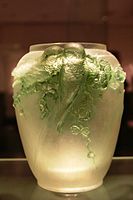René Lalique
René Lalique | |
|---|---|
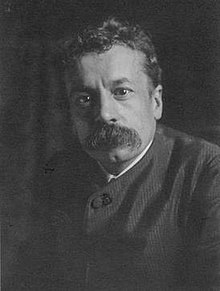 | |
| Born | 6 April 1860 Aÿ, Marne, France |
| Died | 1 May 1945 (aged 85) Paris, France |
| Nationality | French |
| Alma mater | Collège Turgot, Ecole des arts décoratifs, Crystal Palace School of Art |
| Known for | Glass art |
| Spouse(s) | Marie-Louise Lambert Alice Ledru (1870–1909), second wife |
| Children | Marc Lalique Augustine-Alice Ledru René-Claude Le Mesnil Raymond Anère Georgette-Renée Lalique Suzanne Lalique-Haviland Renée Anère |
René Jules Lalique (6 April 1860 – 1 May 1945)[1][2] was a French glass designer known for his creations of glass art, perfume bottles, vases, jewellery, chandeliers, clocks, and automobile hood ornaments.[3][1][4][5]
Life[]
Lalique's early life was spent learning the methods of design and art he would use in his later life. At the age of two, his family moved to the suburbs of Paris, but traveled to Aÿ for summer holidays. These trips influenced Lalique later on in his naturalistic glasswork. With the death of his father, Lalique began working as an apprentice to goldsmith Louis Aucoc in Paris. Lalique died on 1 May or 5 May 1945, in Paris. René Lalique was buried in Père Lachaise Cemetery in Paris, France. His granddaughter, Marie Claude-Lalique (b. 1936), was also a glass maker. She died on 14 April 2003 in Fort Myers, Florida.[1][2]
Education[]
In 1872, when he was twelve, he entered the where he started drawing and sketching. He attended evening classes at the Ecole des arts décoratifs. He worked there from 1874 to 1876 and subsequently spent two years at the Crystal Palace School of Art Sydenham, London. During that time, he also practised as an apprentice goldsmith to leading Parisian Art Nouveau jeweller and goldsmith Louis Aucoc. At the Sydenham Art College, his skills for graphic design were improved, and his naturalistic approach to art was further developed.[1]
Art Nouveau jewellery designer[]
When he returned from England, he worked as a freelance artist, designing pieces of jewellery for French jewelers Cartier, Boucheron, and others. In 1885, he opened his own business and designed and made his own jewellery and other glass pieces. After 1895, Lalique also created pieces for Samuel Bing's Paris shop, the Maison de l'Art Nouveau, which gave Art Nouveau its name. One of Lalique's major patrons was Calouste Sarkis Gulbenkian, who commissioned more than 140 of his works over nearly 30 years.[6]
Glass maker[]
Lalique was best known for his creations in glass art.[3] In the 1920s, he became noted for his work in the Art Deco style. He was responsible for the walls of lighted glass and elegant coloured glass columns which filled the dining room and "grand salon" of the SS Normandie and the interior fittings, cross, screens, reredos and font of St. Matthew's Church at Millbrook in Jersey (Lalique's "Glass Church").[7] As part of the Art Nouveau style, many of his jewellery pieces and vases showcase plants, flowers and flowing lines.[8]
Both unique and commercial works of René Lalique are in the collections of a large number of public museums around the world including the Museu Calouste Gulbenkian in Lisbon, the Lalique Museum of Hakone in Japan, the and the Musée des Arts Décoratifs in France, the in Germany, the Victoria and Albert Museum in London, the Metropolitan Museum and the Corning Museum in New York State, and the Rijksmuseum in Amsterdam.[1]
Works[]
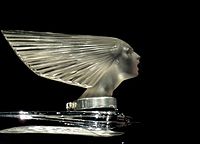
Citroën Company Spirit of the Wind, Blackhawk Museum

Horse

Cicadas, Museu Calouste Gulbenkian

1956 Rolls-Royce Silver Wraith, glass model
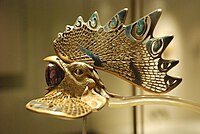
Tiara, Museu Calouste Gulbenkian

Lalique Hood ornament
Glass vase

Fern Leaves Brooch, Walters Art Museum, Baltimore

Medusa

Lalique glass altarpiece in St. Matthew's Church (the Glass Church), Millbrook, Jersey

Dragonfly lady brooch, Museu Calouste Gulbenkian, acquired from the artist in 1903[9]
Glass vase, Museu Calouste Gulbenkian

Pendant, Museu Calouste Gulbenkian

Necklace designed for Lalique's second wife, Alice Ledru, ca 1897–99, Metropolitan Museum of Art, New York

A lighting fixture in the great dining room in the Tokyo Metropolitan Teien Art Museum.
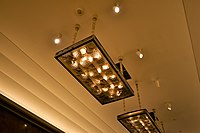
A lighting fixture in the great dining room in the Tokyo Metropolitan Teien Art Museum.

Corsage ornament, Khalili Collection of Enamels of the World

Nude Venus of René Lalique in the Mougins Museum of Classical Art
See also[]
References[]
- ^ Jump up to: a b c d e "Rene Lalique - A Giant Among Giants". rlalique.com. Retrieved 5 January 2016.
- ^ Jump up to: a b BNF 12101962w
- ^ Jump up to: a b Warmus, William (2003). The essential René Lalique. New York: Wonderland Press: Harry N. Abrams. ISBN 9780810958364.
- ^ "René Lalique: Enchanted by Glass". Corning Museum of Glass. Corning Museum of Glass. Retrieved 5 January 2016.
- ^ "Lalique, more than a name". Musée Lalique. Archived from the original on 22 December 2015. Retrieved 5 January 2016.
- ^ Yager, Jan (1998). "Patrons who make history" (PDF). Art Jewelry Forum (4). Retrieved 26 January 2020.
- ^ Jane Ashelford, 1980, "Lalique's Glass Church," The Journal of the Decorative Arts Society, Vol. 4, pp. 28–33.
- ^ "It's All in the Details". ABA Journal. American Bar Association. 86: 88. June 2000. ISSN 0747-0088.
- ^ "'Dragonfly' Broach". Museu Calouste Gulbenkian. Archived from the original on 2 December 2015. Retrieved 5 January 2016.
Bibliography[]
- Bayer, Patricia & Waller, Mark: The Art of René Lalique, Bloomsbury Publishing Ltd, London 1988 ISBN 0-7475-0182-3
- Dawes, Nicholas M.: Lalique Glass, Crown Publishers, London 1986 ISBN 978-0-517-55835-5
- Elliott, Kelley J. René Lalique: Enchanted by Glass, The Corning Museum of Glass, Corning, New York 2014. ISBN 978-0-300-20511-4
- Weiner, Geoffrey George Unique Lalique Mascots, The Book Guild Ltd., Brighton 2014 ISBN 978-1909-984219
External links[]
| Wikimedia Commons has media related to René Lalique. |
- Rene Lalique Biography at RLalique.com.
- Lalique company, with a biography of the artist from the company web site.
- "René Lalique -Oranges vase". Victoria and Albert Museum. Retrieved 15 November 2007.
- This is Jersey article on St Matthew's Millbrook, the "Glass Church".
- Musée Lalique official website of French museum entirely about Lalique
- René Lalique in American public collections, on the French Sculpture Census website

- 1860 births
- 1945 deaths
- Art Nouveau designers
- Art Deco designers
- Burials at Père Lachaise Cemetery
- French decorative artists
- Glass artists
- French jewellery designers
- People from Marne (department)











